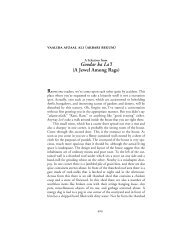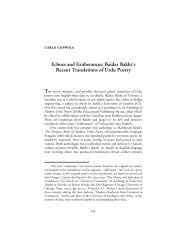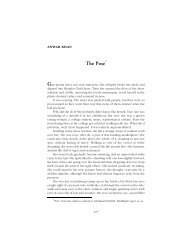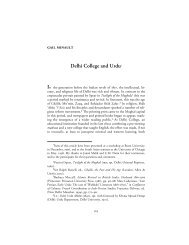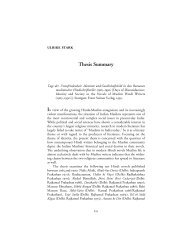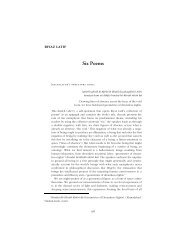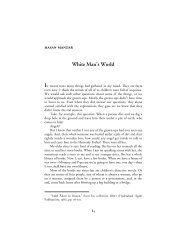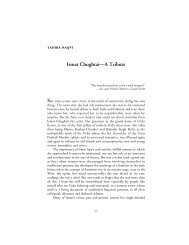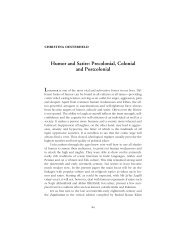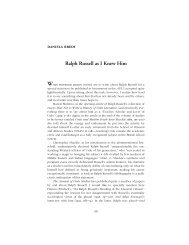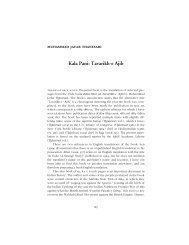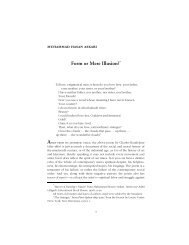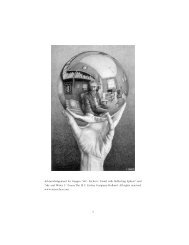Politics, Public Issues and the Promotion of Urdu Literature: Avadh ...
Politics, Public Issues and the Promotion of Urdu Literature: Avadh ...
Politics, Public Issues and the Promotion of Urdu Literature: Avadh ...
You also want an ePaper? Increase the reach of your titles
YUMPU automatically turns print PDFs into web optimized ePapers that Google loves.
ULRIKE STARK • 89Sarsh≥r’s novel Sair-e Kohs≥r, a titillating narrative about a young Nawab’sillicit affair with a low-caste woman, prompted Avad^ Pan± to publiclyurge <strong>the</strong> government to take legal action against Naval Kishore for publishinga “very obscene” novel in a paper delivered to countless schools in<strong>the</strong> province. 64Fas≥na-e ¥z≥d was published in installments in AA from 13 August1878 to January 1880. 65 It started out as a series <strong>of</strong> humorous sketches( ar≥fat), published in loose succession. With its vivid <strong>and</strong> humorous portrayal<strong>of</strong> contemporary social life in Lucknow, it took <strong>the</strong> reading publicby storm <strong>and</strong>, from January 1879, was published at daily intervals. WhileSarsh≥r’s claims to Fas≥na-e ¥z≥d being a “modern novel” remain controversial,66 its publishing pattern marked <strong>the</strong> breakthrough <strong>of</strong> a new narrativegenre in <strong>Urdu</strong>—<strong>the</strong> serialized novel. As <strong>the</strong> first piece <strong>of</strong> original fictionin <strong>Urdu</strong> written expressly for publication in a newspaper, Fas≥na-e¥z≥d broke new ground: For one, it was a text conceived in installments,dem<strong>and</strong>ing self-contained units which were sufficiently barbed with suspenseto hook <strong>the</strong> reader to <strong>the</strong> plot before he was relegated to <strong>the</strong> nextissue <strong>of</strong> <strong>the</strong> paper by <strong>the</strong> inevitable “b≥qµ ≥’inda …” (“to be continued...”). Daily intervals imposed enormous pressure on <strong>the</strong> writer. The regulardoses <strong>of</strong> opium that Sarsh≥r was allegedly supplied with by <strong>the</strong> publishermay be a reflection <strong>of</strong> this. More important than <strong>the</strong> dem<strong>and</strong>s that<strong>the</strong> new mode <strong>of</strong> writing put on <strong>the</strong> author, however, was <strong>the</strong> new form<strong>of</strong> reader-writer interaction prompted by serial publication in a paper.Reader reaction to Fas≥na-e ¥z≥d was vivid, testifying to <strong>the</strong> existence <strong>of</strong> acritical literary public that was eager to discuss <strong>the</strong> notion <strong>of</strong> realism inliterary fiction. Readers <strong>of</strong> AA sent in letters <strong>of</strong> criticism or suggestions towhich Sarsh≥r readily responded with comments or ad hoc modificationsin <strong>the</strong> plot <strong>of</strong> his narrative. 6764Avad^ Pan± <strong>of</strong> 20 May 1886, SVN 1886, p. 406.65 For <strong>the</strong> publishing history <strong>of</strong> Fas≥na-e ¥z≥d, see Mookerjee, pp. 78–80. AsMookerjee points out, <strong>the</strong> common notion that <strong>the</strong> novel was published in AAfrom December 1878 to December 1879 is based on an incorrect statement givenin <strong>the</strong> first printed edition <strong>of</strong> 1880.66 For a discussion <strong>of</strong> Fas≥na-e ¥z≥d under this aspect, see, e.g., Mookerjee,pp. 87–97, Ralph Russell The Pursuit <strong>of</strong> <strong>Urdu</strong> <strong>Literature</strong>, A Select History (Delhi:Oxford University Press, 1992) pp. 87–92, <strong>and</strong> M. Asaduddin, “First <strong>Urdu</strong>Novel: Contesting Claims <strong>and</strong> Disclaimers,” Annual <strong>of</strong> <strong>Urdu</strong> Studies, No. 16 (1),2001, pp. 84–6.67 Mookerjee, pp. 102–33.



